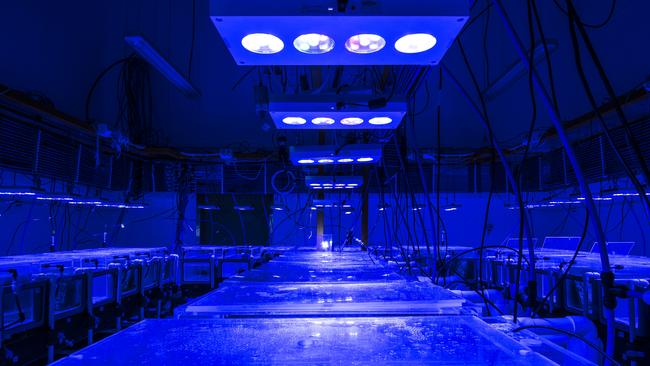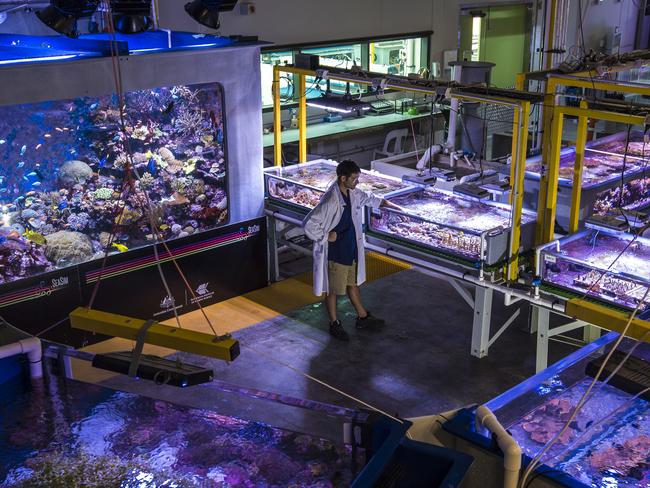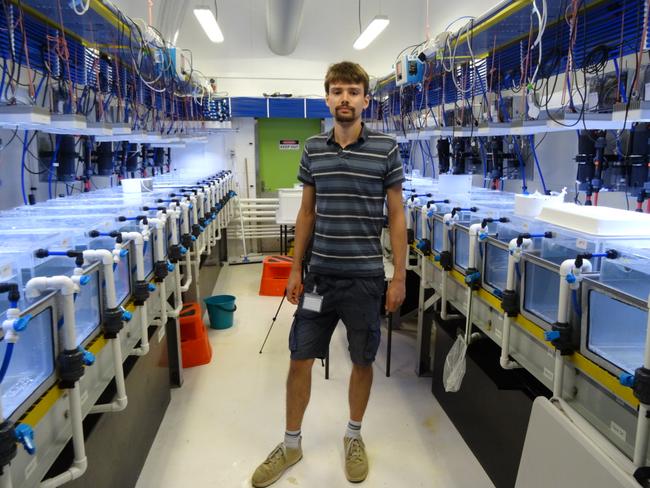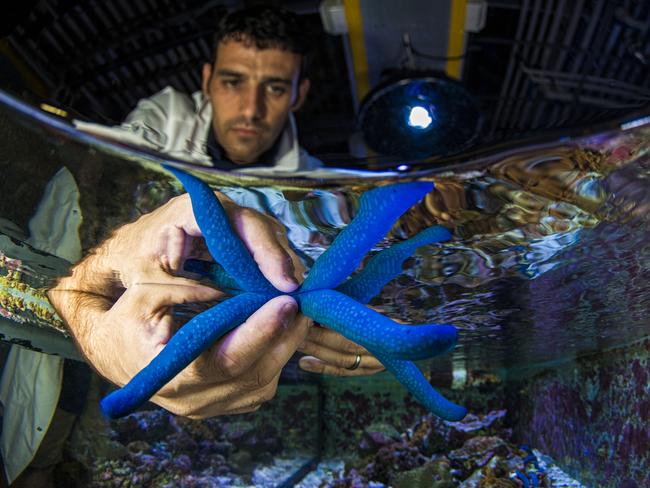The radical idea that could save an Aussie icon
MORE than $40 million has been pumped into a hi-tech research facility in Australia powered by nuclear technology, but has it come too late?
STANDING in front of the loud whirring of the pumps powering Australia’s $40 million SeaSim, Craig Humphrey reflects on how far he’s come.
Just three short years ago the biologist was a humble researcher putting together his own experiments. “I would buy water heaters, I’d go buy the plumbing and I’d put it together myself. It wasn’t very sophisticated,” he said.
If that was a reflection of the primitive state of Australia’s research into the Great Barrier Reef back then, the hi-tech facility Mr Humphrey stands in today hopefully points to a brighter future.
But it is a race against time, with researchers at the National Sea Simulator, known as SeaSim, only just starting to deliver vital information into the impacts of dredging and climate change to coral reef systems.
Meanwhile, a $16 billion dollar mine has already been approved that will see 1.1 million cubic metres of spoil dredged near the Great Barrier Reef Marine Park.
Mr Humphrey acknowledges that government decisions have so far been based on the sparse information that’s currently available.
“We don’t have good quality information on the impacts of dredging and sedimentation so that makes it really difficult for policy makers to make decisions,” Mr Humphrey said.

But SeaSim hopes to change that.
“We’ve had aquarium facilities here for 20 or 30 years (but they were) pretty primitive,” Mr Humphrey explains during a tour of the facility.
Now researchers have access to a world-class facility that includes an expert team of engineers, technicians and plumbers who monitor experiments 24 hours a day, 365 days a year.

The SeaSim, built as part of the Australian Institute of Marine Science, allows scientists to perform experiments in sophisticated aquariums that can be finely controlled for different combinations of water temperature, pH, carbon dioxide, light and seawater.
“SeaSim gives us a capability we have never had before in terms of the complexity of experiments we can carry out,” AIMS research director David Souter said.
It will even feature in an upcoming episode of David Attenborough’s Great Barrier Reef series.
In sharp contrast to Mr Humphrey’s amateur setup, the SeaSim’s tanks are controlled by industrial technology developed by Siemens.
“They run nuclear power plants with this system, so that’s the level we’re talking about,” Mr Humphrey said.

The caution is understandable given the consequences of a breakdown. One glitch could see months, or even years worth of scientific work disrupted.
Last month SeaSim began one of its most ambitious programs, called Evolution in the 21st Century, and this project is expected to run for five years, maybe even longer. It could hold the key to the reef’s survival.
EVOLUTION 21
In a collection of outdoor tanks, SeaSim has just started testing a radical theory about genetics.
As part of the experiment, coral, sponges, seaweed and other marine life are put into tanks set at the higher water temperatures and pCO2 (partial pressure of carbon dioxide levels) estimated for 2050 and 2100.
Scientists want to know whether they can adapt, but more interestingly whether they will pass this ability on to their offspring.
In the past scientists thought that changes to genes could only be inherited if there was a change to the DNA sequence and the mutation was passed on.
But through the study of epigenetics, they now believe it’s possible for environmental factors to cause slight chemical changes that sit on top of genes and for these to be passed on much faster.
“Even in humans it’s been shown that post-war generations in Germany for example, their stress ... being involved in the war has been transferred on to the next generation through epigenetic markers,” senior research scientist Dr Sven Uthicke said.
This type of environmentally-induced change to genes enables DNA to function differently and is more easily inherited by the next generation.
“So we’re trying to look at some of these novel mechanisms that haven’t normally been considered,” principal research scientist Dr Nicole Webster said.
She said most of the predictions and modelling of the reef showed animals would not be able to change fast enough to survive, but that was based on very little experimental advice.

There is already emerging research from James Cook University that fish who spawn at higher temperatures were more likely to deal with higher temperatures than those spawned at lower temperatures.
“So there is a capacity for these guys to adapt and acclimate to those conditions, (and we’re) trying to replicate this with corals,” Mr Humphrey said.
Previous research has also not allowed for natural fluctuations in carbon dioxide levels in the ocean, which are higher at night, and also rise and fall depending on the seasons.
That’s where SeaSim’s technology is crucial because it allows scientists to raise and lower carbon dioxide levels to mimic this pattern, something they have not been able to do before.

“It’s closer to what’s actually occurring on the reef,” Mr Humphrey said. “What we’re trying to do is get closer and closer to real world situations and improving those measurements.”
Another advantage is that the experiment is expected to run for at least five years, enough time for some species of coral to reproduce several times, allowing scientists to better judge whether future generations can cope with higher temperatures and other changes.
“The ultimate aim of the project is to better ground (policy) with some actual data. Can these organisms adapt? If they can, how fast can that actually occur? In how many generations can we see that adaptation?” Dr Webster said.
She believes the ability to adapt will vary depending on the species. Researchers have chosen corals and other sea life that reproduce relatively quickly and the first results from the experiment should be available by the end of the year or early 2017.
DREDGING
Another area of research that the institute is involved in, is measuring the impacts of dredging and sedimentation on corals and sponges.
Dredging involves digging up the seabed to make it deeper so larger ships can travel through but it stirs up particles that can literally smother coral and sponges.
The research has been commissioned by the Western Australia Marine Science Institute to specifically look at the impacts of dredging in the state but Dr Webster hopes that it will also be relevant to the Great Barrier Reef.

“I would certainly like to think that as a researcher that’s why we’re doing it, to have meaning to our science,” she said.
“There’s a dire need I think for that really experimental information.”
Unfortunately the information could come too late to help the Great Barrier Reef, which recently saw the approval of Adani’s $16 billion Carmichael coal mine that will involve dredging 1.1 million cubic metres of spoil near the Great Barrier Reef Marine Park.
“It does come very late,” Dr Webster said of the research, with findings not due until September. “And I think that’s what happens when you get a very rapid expansion of industry development.”
News.com.au asked the Queensland Department of Environment whether environmental approval of the mine could be reconsidered if new scientific evidence on potential impacts was provided, but it did not respond before deadline.
Mr Humphrey said there was a crucial need for data so economic activity could be balanced with protecting the environment.

“The only real way to do that is to provide really good quality data that enables the policy makers to make a valid decision,” he said.
“If that data doesn’t exist, then it’s really, really difficult to make the right decision.”
*Charis Chang travelled to Townsville as a guest of Siemens
charis.chang@news.com.au



